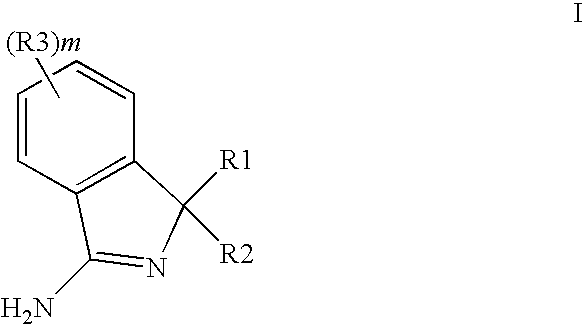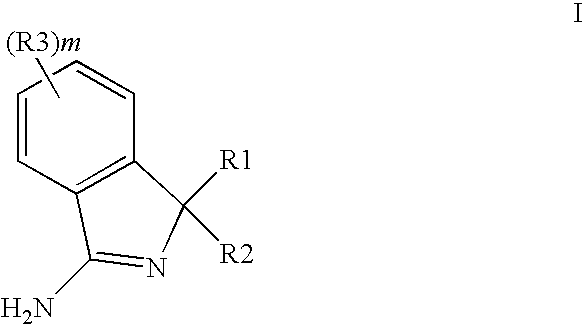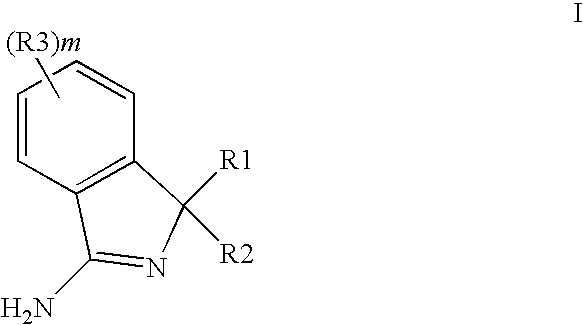New Compounds 391
a new type of compound and compound technology, applied in the field of new compounds 391, can solve the problems of high prevalence of alzheimer's disease in this population, disease becomes a greater and greater problem, etc., and achieve the effect of improving herg selectivity and beneficial properties
- Summary
- Abstract
- Description
- Claims
- Application Information
AI Technical Summary
Benefits of technology
Problems solved by technology
Method used
Image
Examples
example 1
3,3-Diphenyl-3H-isoindol-1-ylamine (Scheme #1, A)
[0265]
[0266]To a −78° C. cooled solution of 1,2-dicyanobenzene (200 mg, 1.56 mmol) in tetrahydrofuran (10 mL) was added 1.8 M phenyllithium in di-n-butylether (1.73 mL, 3.12 mmol). After 30 minutes the reaction was warmed to room temperature and quenched by adding water (1.5 mL) and the solvent removed under reduced pressure. The brown solid was purified by reverse-phase HPLC using acetonitrile / water as the mobile phase on a C18 column with the following gradient:
time% water% acetonitrile080204782215.5307016.51090178020198020
[0267]A second purification was required using preparative SFC using a Berger pyridyl column with a gradient of 10-35% MeOH.CO2 for 8 min (RT=5.36 min) to give the title compound as a white solid (37 mg, 8%). 1H NMR (300 MHz, DMSO-d6) δ 7.77-7.73 (m, 1H), 7.64 (t, J=4.3 Hz, 1H), 7.41 (dt, J=8.8, 4.9 Hz, 2H), 7.30-7.14 (m, 10H); MS (TOF ES+) m / z 285 [M+1]+; tR=6.65 min. Exact Mass: Calculated 285.1392, Found 285.13...
example 2
3-(3′-Methoxy-biphenyl-3-yl)-3-(4-methoxy-phenyl)-3H-isoindol-1-ylamine trifluoroacetate (Scheme #2, H)
[0268]
[0269]To trifluoro-methanesulfonic acid 5-[3-tert-butoxycarbonylamino-1-(4-methoxy-phenyl)-1H-isoindol-1-yl]-3′-methoxy-biphenyl-2-yl ester (Scheme #2, G) (50 mg, 0.075 mmol) was added potassium phosphate (32 mg, 0.15 mmol), dichlorobis(triphenylphosphine)palladium(II) (16 mg, 0.022 mmol), and 1,2-dimethoxyethane: water:ethanol (7:3:2, 2.0 mL). The reaction was heated in a microwave at 125° C. for 15 minutes, more dichlorobis(triphenylphosphine)palladium(II) (16 mg, 0.022 mmol) was added, and the reaction reheated at 125° C. for 15 minutes. The solvent was removed under reduced pressure and the crude material dissolved in acetonitrile / water with trifluoroacetic acid (75:25:0.1, 1.0 mL), the insoluble material was filtered off and the filtrate was purified using RP-HPLC AG1 (tR=21.2 min). The combined purified fractions were lyophilized to give the title compound (9.0 mg). 1H ...
example 3
Trifluoro-methanesulfonic acid 5-[3-amino-1-(4-methoxy-phenyl)-1H-isoindol-1-yl]-3′-methoxy-biphenyl-2-yl ester trifluoroacetate
[0272]
[0273]To trifluoro-methanesulfonic acid 5-[3-tert-butoxycarbonylamino-1-(4-methoxy-phenyl)-1H-isoindol-1-yl]-3′-methoxy-biphenyl-2-yl ester (Scheme #2, G) (22.5 mg, 33.6 umol) was added trifluoroacetic acidin dichloromethane (10%, 1-2 mL) and reaction stirred 60 minutes. The solvents were removed under reduced pressure and the resulting gum put under high vacuum at 50° C. over night to give the title compound as a waxy solid (22.9 mg). 1H NMR (300 MHz, DMSO-d6) δ 8.30 (d, J=7.7 Hz, 1H), 7.88 (q, J=8.2 Hz, 2H), 7.77-7.71 (m, 1H), 7.62-7.59 (m, 1H), 7.49-7.38 (m, 3H), 7.20-7.16 (m, 2H), 7.05-6.96 (m, 5H), 3.78 (s, 3H), 3.74 (s, 3H); MS (APCI+) m / z 569 [M+1]+; tR=2.64 min.
PUM
 Login to View More
Login to View More Abstract
Description
Claims
Application Information
 Login to View More
Login to View More - R&D
- Intellectual Property
- Life Sciences
- Materials
- Tech Scout
- Unparalleled Data Quality
- Higher Quality Content
- 60% Fewer Hallucinations
Browse by: Latest US Patents, China's latest patents, Technical Efficacy Thesaurus, Application Domain, Technology Topic, Popular Technical Reports.
© 2025 PatSnap. All rights reserved.Legal|Privacy policy|Modern Slavery Act Transparency Statement|Sitemap|About US| Contact US: help@patsnap.com



